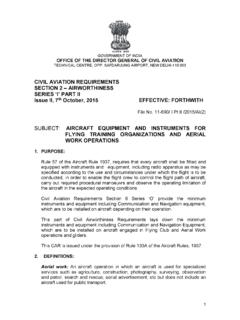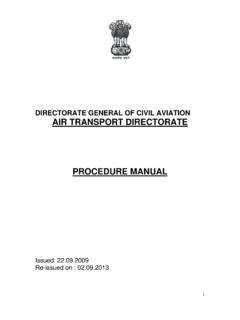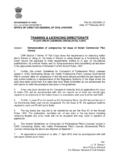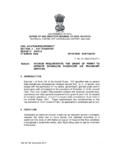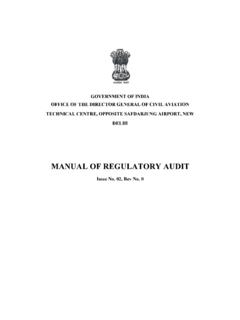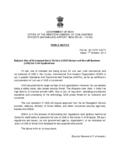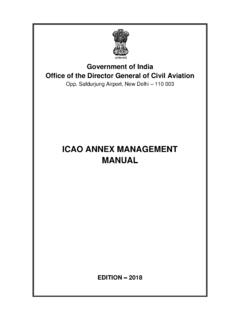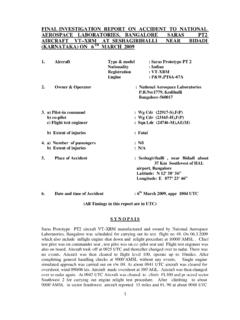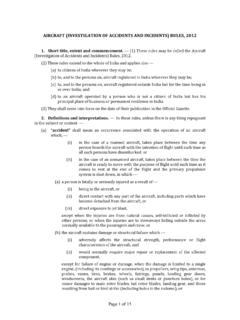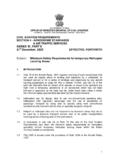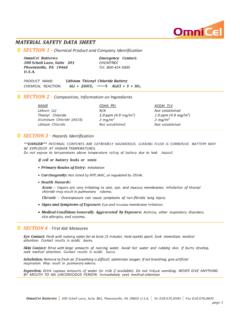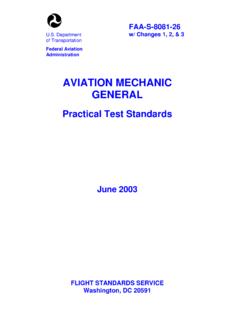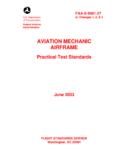Transcription of CIVIL AVIATION REQUIREMENTS SECTION 1 – …
1 GOVERNMENT OF INDIA. OFFICE OF THE DIRECTOR GENERAL OF CIVIL AVIATION . TECHNICAL CENTRE, OPPOSITE SAFDARJUNG AIRPORT, NEW DELHI 11 0 003. CIVIL AVIATION REQUIREMENTS . SECTION 1 GENERAL. SERIES 'C' PART I. Issue II, 27th July 2017 EFFECTIVE: FORTHWITH. 15011/19/2017-AS. Subject: Establishment of a Safety Management System (SMS). 1. INTRODUCTION. The ICAO safety management SARPs as contained in its Annex 19 to the convention, provide the high-level REQUIREMENTS , which the States are required to implement to fulfil their safety management responsibilities related to, or in direct support of, the safe operation of aircraft. In compliance with the standards of ICAO Annexes, various CARs specify the REQUIREMENTS for the establishment of SMS by a service provider. This CAR. specifies the minimum acceptable REQUIREMENTS for the establishment of SMS. by a service provider. This CAR lays down the AVIATION safety-related processes, procedures and activities for the establishment of SMS by a service provider and is issued in accordance with rule 29D and rule 133A of the Aircraft Rules, 1937.
2 2. APPLICABILITY. The provisions of this CAR are applicable to an applicant for, or a holder of, one of the following approvals/permits/licence: i) Scheduled or Non-Scheduled Operator's Permit issued under rule 134. or 134A. ii) Conducting operations of large or turbojet aeroplanes for general AVIATION . iii) Engaged in the operation of an aerodrome licensed under rule 78. iv) Engaged in the type design of aircraft. v) Engaged in manufacture of aircraft. 1. CIVIL AVIATION REQUIREMENTS SECTION 1. SERIES C PART I 27TH JULY 2017. vi) Maintenance organization approved under rule 133B. vii) Training organization approved under rule 41B. viii) An air traffic service provider. 3. DEFINITIONS. Acceptable level of safety performance (ALoSP): The minimum level of safety performance of CIVIL AVIATION in a State, as defined in its State safety programme, or of a service provider, as defined in its safety management system, expressed in terms of safety performance targets and safety performance indicators.
3 Accountable executive: A single, identifiable person having responsibility for the effective and efficient performance of the State's SSP or of the service provider's SMS. Change management: A formal process to manage changes within an organization in a systematic manner, so that changes which may impact identified hazards and risk mitigation strategies are accounted for, before the implementation of such changes. Defences: Specific mitigating actions, preventive controls or recovery measures put in place to prevent the realization of a hazard or its escalation into an undesirable consequence. Errors: An action or inaction by an operational person that leads to deviations from organizational or the operational person's intentions or expectations. Hazard: A condition or an object with the potential to cause or contribute to an aircraft incident or accident. High consequence indicators: Safety performance indicators pertaining to the monitoring and measurement of high consequence occurrences, such as accidents or serious incidents.
4 High-consequence indicators are sometimes referred to as reactive indicators. Gap analysis: a gap analysis is basically an analysis of the safety arrangements already existing within the organization as compared to those necessary for SMS function Inappropriate use: use of safety information for purposes different from the purposes for which it was collected, namely, use of the information for disciplinary, CIVIL , administrative and criminal proceedings against operational personnel, and/or disclosure of the information to the public. (ICAO Annex 13/19). Industry codes of practice: Guidance material developed by an industry body, for a particular sector of the AVIATION industry to comply with the REQUIREMENTS of the International CIVIL AVIATION Organization's Standards and Recommended 2. CIVIL AVIATION REQUIREMENTS SECTION 1. SERIES C PART I 27TH JULY 2017. Practices, other AVIATION safety REQUIREMENTS and the best practices deemed appropriate. Just Culture: It is a culture in which personnel are not punished for actions, omissions or decisions taken by them which are commensurate with their experience and training, but where gross negligence, wilful violations and destructive acts are not tolerated.
5 Lower consequence indicators: Safety performance indicators pertaining to the monitoring and measurement of lower-consequence occurrences, events or activities such as incidents, non-conformance findings or deviations. Lower- consequence indicators are sometimes referred to as proactive/predictive indicators. Operational personnel: Personnel involved in AVIATION activities who are in a position to report safety information. Note. Such personnel include, but are not limited to: flight crews; air traffic controllers; aeronautical station operators; maintenance technicians;. personnel of aircraft design and manufacturing organizations; cabin crews;. flight dispatchers, apron personnel and ground handling personnel. Risk mitigation: The process of incorporating defences or preventive controls to lower the severity and/or likelihood of a hazard's projected consequence. Safety. The state in which risks associated with AVIATION activities, related to, or in direct support of the operation of aircraft, are reduced and controlled to an acceptable level.
6 Safety information: Information contained in Safety Data Collection and Processing System (SDCPS) established for the sole purpose of improving AVIATION safety, and qualified for protection under specified conditions. Safety management system: A systematic approach to managing safety, including the necessary organizational structures, accountabilities, policies and procedures. Safety performance: A State's or service provider s safety achievement as defined by its safety performance targets and safety performance indicators. Safety performance indicator: A data-based safety parameter used for monitoring and assessing safety performance. Safety risk: The predicted probability and severity of the consequences or outcomes of a hazard. Safety data: A defined set of facts or set of safety values collected from various AVIATION -related sources, which is used to maintain or improve safety. Note. Such safety data is collected from proactive or reactive safety-related 3. CIVIL AVIATION REQUIREMENTS SECTION 1.
7 SERIES C PART I 27TH JULY 2017. activities, including but not limited to: a) accident or incident investigations;. b) safety reporting;. c) continuing airworthiness reporting;. d) operational performance monitoring;. e) Inspections, audits, surveys; or f) safety studies and reviews Safety oversight: A function performed by a State to ensure that individuals and organizations performing an AVIATION activity comply with safety-related national laws and regulations. Safety performance target: The State or service provider's planned or intended target for a safety performance indicator over a given period that aligns with the safety objectives. State of Design: The state having jurisdiction over the organisation responsible for the type design. State of Manufacture: The state having jurisdiction over the organisation responsible for the final assembly of the aircraft. Service Provider: refers to any organisation providing AVIATION services. The term includes approved training organisations, organisations responsible for type design and/or manufacture of aircraft/engines, air traffic service providers, Ground handling service providers, air traffic service providers, as applicable.
8 State safety programme: An integrated set of regulations and activities aimed at improving safety. Surveillance. The State activities through which the State proactively verifies through inspections and audits that AVIATION licence, certificate, authorization or approval holders continue to meet the established REQUIREMENTS and function at the level of competency and safety required by the State. 4. GENERAL. The applicant of, or holder of an approval/certificate/licence, as specified in Para 2 of this CAR shall develop, establish, maintain and adhere to a safety management system. SMS framework shall incorporate four components and twelve key elements, as follows: Safety policy and objectives i) Management commitment ii) Safety accountability and responsibilities iii) Appointment of key safety personnel 4. CIVIL AVIATION REQUIREMENTS SECTION 1. SERIES C PART I 27 THJULY 2017. iv) Coordination of emergency response planning v) SMS documentation Safety risk management i) Hazard identification ii) Safety risk assessment and mitigation Safety assurance i) Safety performance monitoring and measurement ii) The Management of change iii) Continuous improvement of the SMS.
9 Safety promotion i) Training and education ii) Safety communication The safety management system shall be accepted by DGCA. Detailed REQUIREMENTS for the acceptance of a safety management system are laid down in the subsequent paras of this CAR. 5. SAFETY POLICY AND OBJECTIVES. Management Commitment The service provider shall define its safety policy in accordance with international and national REQUIREMENTS . The safety policy statement shall: a) reflect service provider commitment regarding safety, including the promotion of a positive safety culture;. b) include a clear statement about the provision of the necessary resources for implementation of the safety policy;. c) include safety reporting procedures;. d) clearly indicate which types of behaviours are unacceptable related to the service provider's AVIATION activities and include the circumstances under which disciplinary action would not apply;. e) be signed by the accountable executive of the service provider;. f) be communicated, with visible endorsement, throughout the service provider; and g) be periodically reviewed to ensure it remains relevant and appropriate to the service provider.
10 The safety policy statement shall include commitment to: a) achieve the highest safety standards;. b) comply with all applicable regulatory REQUIREMENTS ;. c) comply with international standards;. d) adopt proven best practices appropriate to the activity;. e) provide all the necessary resources;. 5. CIVIL AVIATION REQUIREMENTS SECTION 1. SERIES C PART I 27TH JULY 2017. f) ensure safety is a primary responsibility of all managers;. g) ensure that the safety policy is understood, implemented and maintained at all levels. In order to mitigate the organization's risks, the management shall ensure the following: a) document service provider's priorities;. b) prescribe and document procedures for performing activities/processes;. c) provide training to the staff to develop the necessary knowledge, skills and attitude;. d) provide safety directives and controls to ensure their compliance;. e) procure suitable equipment and systems to support activities and ensure its continuing serviceability; and f) ensure that necessary resources are deployed to maximise the service providers' safety performance.
